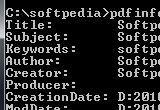

That's it! If you find this video to be helpful, please click the thumbs-up icon below. Just a wrapper around the pdfinfo command (for collecting PDF file info). Open the text file with whatever text editor you prefer, such as Notepad or WordPad, and you'll see one line in there with the page count. Issue a DIR command in the command prompt to show that the text file was created. The pdfname command-line program names a PDF file using the author, year of creation and title information extracted from the pdfinfo program. Verify that the text file that was created. Pdfinfo test.pdf|find "Pages:">numpages.txtĨ. Testing them with the time command in front shows that the strings one is extremely slow, taking 0.
Pdfinfo command package install#
On debian like Linux, you can install that like this: sudo apt-get install poppler-utils The poppler package appears to be present on MacOS via brew so this script could be adapted to work on MacOS as well. Run PDFinfo again, this time piping the output to the FIND filter and then redirecting the output to a text file. This script assumes that the pdfinfo command line command is available at /usr/bin/pdfinfo. In the command prompt window, enter the following command:ħ.

convert -negate flowerimages/.pbm flowerimages.pdf. Here we use the -negate option so the final result is black on white instead of inverted.

Run the PDFinfo utility on the sample PDF file. If we have a collection of image files in a directory, we can compile them into a new PDF using the ImageMagick convert command. They do not open in xpdf nor even acroread and pdfinfo does not detect them. A wrapper around the pdfinfo command line tool, to extract meta data from pdfs. Issue a DIR command in the command prompt to be sure that only two files are in it - the PDFinfo executable and the sample PDF file.Ħ. The files you mention does not seems to be pdf at all. This is the documentation for the PDFinfo tool.Ĭopy from the unzipped folder into your test folder.Ĭopy a sample PDF file into your test folder (in the video and the screenshots below, the file is called test.pdf, which is a PDF file created from my EE article, Windows 10 uses YOUR computer to help distribute itself). On my machine, the command is not recognized. However, a Windows port does exist, here. pdinfo is not included with PowerShell on Windows. Open it with any text editor, such as Notepad, and read it. When I research this, it looks like it should be packaged in some versions of PowerShell but not others. Go into the folder and find the plain text file called. Read the documentation for the PDFinfo tool.
Pdfinfo command package zip file#
Go to the folder where you unzipped the downloaded ZIP file and find the folder.ģ. Locate the documentation folder for the Xpdf utilities. Click the Download link and then click the pre-compiled Windows binary ZIP archive to download the utilities for Windows.Ģ. If you want to have an MSI package for the setup program then we can recommend the enterprise edition or show. You may have already downloaded and unzipped the Xpdf tools while watching the first video in the Xpdf series, but if you haven't, then visit the Xpdf website.


 0 kommentar(er)
0 kommentar(er)
